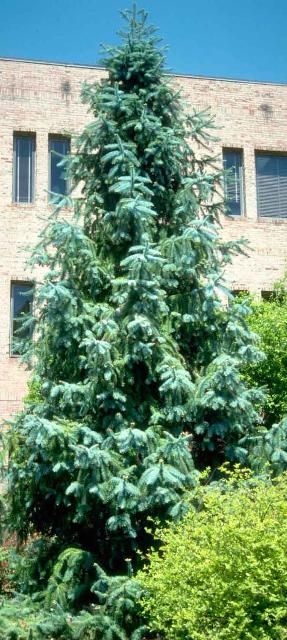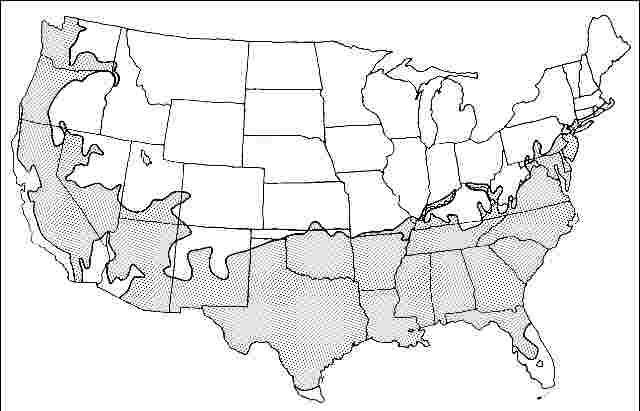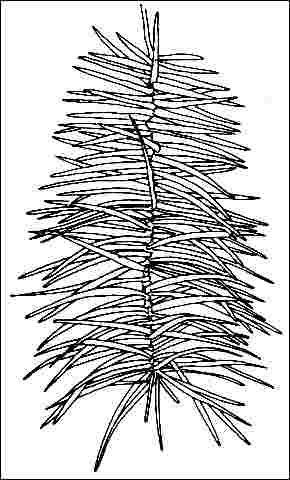Introduction
China fir is an evergreen which is usually seen from 30 to 75 feet in height with a spread of 10 to 30 feet. The strong, heavy trunk stands straight up at the base of the coarse, irregular, pyramidal form which is composed of somewhat pendulous branches densely clothed in 1.5- to 2.5-inch-long, bright green, pointed needles. It is somewhat reminiscent of some of the spruces like blue and white spruce. Occasionally the tree will be grown with several trunks arising from the soil, but above that point the trunk almost never branches into a double or multiple leader, growing up the center of the tree like an arrow and lending a strong vertical accent to any area. The crown is fairly open allowing the trunk and large branches to show prominently. Like other tall-growing trees, it is best to maintain only one central trunk. The leaves take on a bronze hue in autumn and, when they die, persist on the tree on interior branches for many years giving it a somewhat unkempt appearance according to some horticulturists. The attractive, brown, peeling bark strips away to reveal the inner reddish bark, adding to the tree's overall textural interest.

Credit: Ed Gilman, UF/IFAS
General Information
Scientific name: Cunninghamia lanceolata
Pronunciation: kunn-ning-HAM-ee-uh lan-see-oh-LAY-tuh
Common name(s): China fir
Family: Pinaceae
USDA hardiness zones: 6B through 9A (Fig. 2)
Origin: not native to North America
Invasive potential: little invasive potentia
Uses: specimen; screen; urban tolerant; highway median
Availability: somewhat available, may have to go out of the region to find the tree

Description
Height: 50 to 75 feet
Spread: 15 to 30 feet
Crown uniformity: irregular
Crown shape: pyramidal
Crown density: open
Growth rate: moderate
Texture: coarse
Foliage
Leaf arrangement: spiral (Fig. 3)
Leaf type: simple
Leaf margin: ciliate
Leaf shape: lanceolate
Leaf venation: parallel
Leaf type and persistence: evergreen, needled evergreen
Leaf blade length: less than 2 inches
Leaf color: green
Fall color: no color change
Fall characteristic: not showy

Flower
Flower color: unknown
Flower characteristics: not showy
Fruit
Fruit shape: round
Fruit length: 1 to 3 inches
Fruit covering: dry or hard
Fruit color: brown
Fruit characteristics: does not attract wildlife; not showy; fruit/leaves not a litter problem
Trunk and Branches
Trunk/bark/branches: branches droop; showy; typically one trunk; thorns
Pruning requirement: little required
Breakage: resistant
Current year twig color: green
Current year twig thickness: thick
Wood specific gravity: unknown
Culture
Light requirement: full sun, partial sun, or partial shade
Soil tolerances: clay; sand; loam; acidic; well-drained
Drought tolerance: high
Aerosol salt tolerance: unknown
Other
Roots: not a problem
Winter interest: no
Outstanding tree: yes
Ozone sensitivity: unknown
Verticillium wilt susceptibility: resistant
Pest resistance: free of serious pests and diseases
Use and Management
China fir is best used as a specimen, at the corner of a large building, or as a large-scale screen planted 15 to 20 feet apart. Young specimens maintain a fairly tight crown but they open up with age, becoming asymmetrical with large pieces of the crown missing. It works well in oriental gardens and the foliage keeps well indoors in a vase of water. Not a tree you would use everywhere, China fir has its place as an occasional accent and conversation piece, particularly in a park or on a golf course. It is too big for a residential landscape but useful on campuses and other large-scale landscapes.
China fir should be grown in full sun or partial shade (will grow in shade but with poor, open form) on moist, well-drained, acid soil. Although the leaves may be damaged by severe frosts, they are quickly replaced in springtime. China fir is extremely drought tolerant and grows well in poor, compacted clay soil. It is very adapted to urban soils except those poorly drained.
The cultivar 'Glauca' has blue/green foliage.
Propagation is by cuttings.
Pests and Diseases
No pests or diseases are of major concern. Brown foliage stays on the interior branches but this is a normal condition, usually not caused by insects or disease.